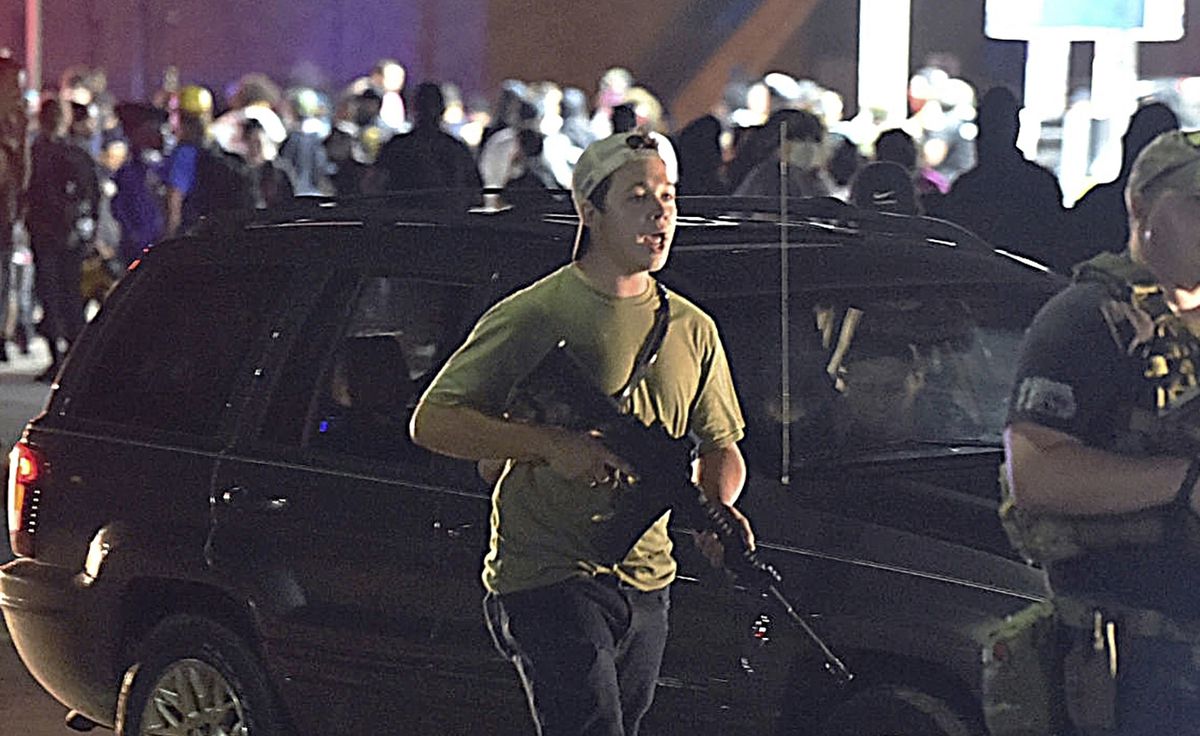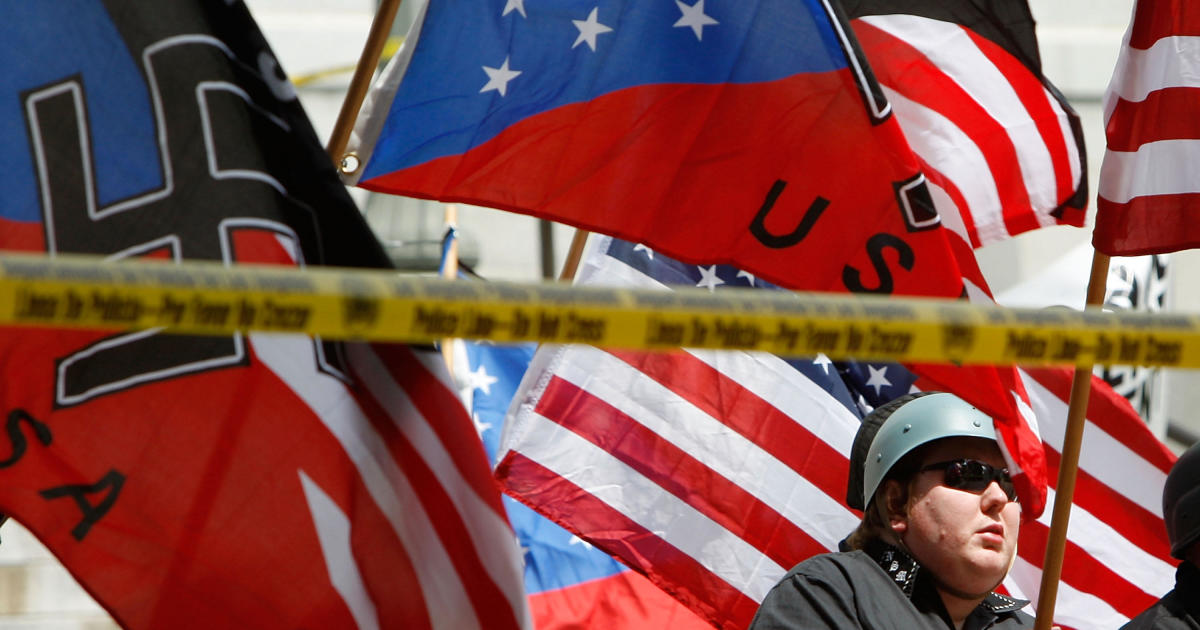
Wherever fascism has risen in the world, it has historically followed the same playbook. Hyper-nationalist demagogues seize on societal discord by inflaming divisions between themselves and marginalized populations, instigating a moral panic, and attempting to seize power by promising to bring a nation in shambles back to glory. Anyone who dissents is silenced, whether by exile, incarceration, or by force. And that use of force can either come from the government itself, or it can be outsourced to vigilantes who act with the tacit blessing of the state. Today’s Republican Party is acting alarmingly similar: Not just in its words and actions, but in its encouragement of vigilante violence to achieve political goals.
Manufactured moral panic
Future historians may very well use our current political moment to illustrate the moral panic that comes just before a fascist seizure of power. One manifestation of that panic is the “critical race theory” conversation that dominated Fox News throughout 2021, which promptly disappeared from the public eye almost immediately after Virginia governor-elect Glenn Youngkin (R) used it to win the 2021 gubernatorial election.
The Washington Post reported that mentions of “critical race theory” (a graduate-level academic concept not taught in K-12 schools that examines racial bias in contemporary institutions) on Fox News dropped off precipitously shortly after the Virginia election, despite the topic dominating airwaves in the months prior. Now, the political right is moving the goalposts even more. In a recent tweet, far-right pundit Christopher Rufo, who popularized the use of the term to include any and all discussions of racism in schools, called on his quarter million-plus followers to “remove the attorney general, lay siege to the universities, abolish the teachers unions, and overturn the school boards.”
This sounds like hyperbole, but punishing thoughtcrime by attacking educational institutions is actually perfectly in line with the fascist playbook. Nazi Germany’s Operation Sonderaktion Krakau rounded up professors from various universities in Poland’s capital city and interned them at concentration camps for having a “hostile attitude towards German science.” More recently, Brazilian President Jair Bolsonaro -- who based his 2018 campaign on encouraging brutality and violence against marginalized people -- made moves to gut public university funding, specifically for philosophy and sociology programs. After Bolsonaro won the first round of elections in 2018, Brazilian police raided universities, sometimes without warrants, to question professors and confiscate materials critical of fascism.
While state repression of education has been frequent throughout history, vigilantism against public officials has been weaponized more recently in the United States. Violence and the threat of violence became so widespread during the manufactured Critical Race Theory panic that the FBI began tracking threats to school board members for the first time this year. In many cases, the new hyper-politicized climate at local board meetings has led to a wave of resignations at school boards across the country. And these resignations aren’t limited to school boards: Following former President Donald Trump’s defeat in 2020, election workers in states across the US were so inundated with death threats that many ended up resigning from their posts.
Right-wing vigilantism is spreading rapidly
Even prior to Kyle Rittenhouse’s acquittal, the trial brought out vigilantes inspired by Rittenhouse’s killing of Black Lives Matter protesters. Former Ferguson, Missouri police officer Jesse Theodore Kline, who was fired in 2018 after allegedly threatening a man with a gun while he was off-duty, has been seen with a rifle leading anti-Black Lives Matter chants outside the courthouse in Kenosha, Wisconsin. Right-wing podcaster Steven Crowder encouraged the right to “mobilize and counter” Black Lives Matter protests that arise from a not guilty verdict. It’s likely that Rittenhouse walking free will be interpreted by far-right vigilantes as a green light to bring weapons to future demonstrations and look for any excuse to shoot protesters without fear of accountability.
Both fascist Italy and Nazi Germany saw the far right rise to power with the help of vigilante violence. In the book Ordinary Violence in Mussolini’s Italy, author Michael R. Ebner delved into how fascism quickly spread following campaigns of terror and violence aimed at prominent socialists. Despite pro-working class politicians winning key elections under the socialist banner across Italy between 1918 and 1920, and despite labor unions winning major concessions from business owners following massive strikes, socialism in Italy was brutally crushed by the end of 1922. Benito Mussolini gave his blessing to the heinous acts carried out by vigilante “blackshirts,” calling it “heroism.”
“In the provincial centers, Fascist violence was initially used to break the Socialist hold on local administration and labor organizations. Fascists interrupted meetings, beat elected officials, and made impossible the work of local government. Socialists in particular were intimidated, threatened, and even beaten until they resigned. The consequences for the Socialist Party, which was entirely unprepared to counter organized, paramilitary violence, were disastrous. In the province of Bologna, one of the “reddest” provinces in the entire Po Valley, where the Italian Socialist Party (PSI) received almost three-quarters of the vote in 1919, the Fascists demolished the Socialist Party in a matter of months. Between March and May 1921, the squads destroyed dozens of newspapers offices, chambers of labor, peasant leagues, cooperatives, and social clubs...
“...Fascist squads thus practiced highly personal, localized strategies of violence and intimidation, attacking the most prominent and influential “subversives” within a given province, town, or comune. Fascists sometimes beat these men, occasionally with homicidal intent, but perhaps more commonly intimidated them until they were forced to leave town, thereby decapitating their organizations. The Fascists spent their weekends chasing prominent peasant leaders across the countryside.
“Thus, life for labor leaders became terror-filled, especially because Fascists did not limit their attacks to the public sphere. Nowhere was safe. Late at night, 10, 30, or even 100 Blackshirts, as these squad members became known, sometimes traveling from neighboring towns, might surround a home, inviting a Socialist, anarchist, or Communist outside to talk. If they refused, the Fascists would enter forcibly or threaten to harm the entire family by lighting the house on fire.”
And of course, Adolf Hitler’s ascent to chancellor was preceded by a wave of violence carried out by the Sturmabteilung (SA), or the “brownshirts.” Hitler deputized the first brownshirts in 1921 to intimidate the Jewish population and labor activists, and to violently break up leftist gatherings. The brownshirts also played a significant role in the 1923 Beer Hall Putsch, in which Hitler and several hundred SA members organized a failed coup attempt against Weimar Germany’s government. While both Hitler and several vigilante leaders were jailed for their role in the Beer Hall Putsch, Hitler used his time in prison to write his manifesto, Mein Kampf, which the Nazi Party used as a recruiting tool. In 1933, Hitler won election as chancellor. The following year, he appointed himself Fuhrer. The rest is history.
January 6: a precursor?
Despite the jailing of several prominent participants in the January 6, 2021 insurrection at the US Capitol -- most notably “QAnon shaman” Jake Angeli, who recently received a 41-month prison sentence -- the Donald Trump-led Republican Party has yet to pay a political price for its attempt to violently overturn the 2020 election. In fact, the party appears to be doubling down on fascism, with Trump still the clear standard-bearer. An October poll by Quinnipiac found Trump still had 86% favorability among Republican adults.
The November 17th censure of Rep. Paul Gosar (R-Arizona) for tweeting an anime video that depicted him killing Rep. Alexandria Ocasio-Cortez (D-New York) showed a largely unrepentant Republican Party, with only two out of 213 Republicans voting to censure Gosar. Rep. Anthony Sabatini (R-Florida) gave an attaboy to Gosar, tweeting “Anime is officially America First now.” Rep. Lauren Boebert (R-Colorado) referred to Rep. Ilhan Omar (D-Minnesota), who is Muslim, as a member of the “Jihad squad.” And House Republican Leader Kevin McCarthy (R-California) promised to reinstate both Gosar and Rep. Marjorie Taylor Greene (R-Georgia) to their committees if Republicans retake the House of Representatives in 2022 (Greene was removed from her committee posts in February for encouraging violence against Democrats and for trafficking in anti-Semitism, racism, and conspiracy theories). Republicans only need a handful of seats in next year’s midterm elections to retake the chamber.
Both Trump and his inner circle have largely avoided accountability for January 6, and subpoenas from the House Select Committee on the January 6 Attack are so far being ignored. While former White House advisor Steve Bannon has been indicted on two counts of contempt of Congress, the Department of Justice didn’t request pre-trial detention for Bannon, even though he hinted at knowledge of the January 6 insurrection on his radio show the day before the attack. And Trump himself may be able to run out the clock following a federal appeals court’s recent decision to delay the release of key January 6 documents. If the November 30 oral arguments don’t go Trump’s way, it’s likely his legal team will appeal to the U.S. Supreme Court, in which a 6-3 conservative majority that includes three Trump appointees will decide whether or not Trump has to comply with the January 6 committee’s request.
The US allowing a fascist coup attempt to go unpunished may end up yielding the same result as the US’ failure to stop al-Qaeda and Osama bin Laden following the 1993 World Trade Center bombing. If the budding fascist movement that’s taken over the Republican Party takes over Congress in 2022, it’s likely that an emboldened Donald Trump could win back the presidency in 2024 and kill democracy for good.
(Stay tuned for part 2 of this series.)
Carl Gibson is a freelance journalist and columnist whose work has been published in CNN, The Guardian, The Washington Post, The Houston Chronicle, Barron’s, Business Insider, The Independent, and NPR, among others. Follow him on Twitter @crgibs.

















